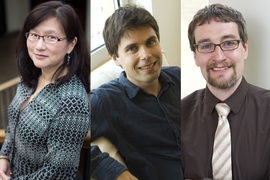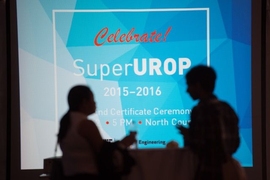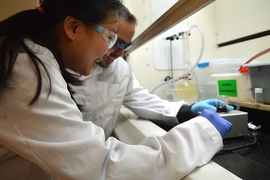Question: What does building a 15th-century printing press have in common with using DNA to encode genetic memory in a cell?
Answer: Both are recent MIT undergraduate research projects conducted through the Undergraduate Research Opportunities Program (UROP) launched in 1969 by Margaret MacVicar, MIT’s first dean for undergraduate education.
MacVicar created numerous far-reaching educational initiatives and championed the then-novel idea that cultivating collaborative research relationships between students and faculty had great educational value. Nearly five decades later, UROP is emulated at universities around the world and is an indispensable part of the MIT experience. More than 2,600 students participate every year, and 90 percent of the Class of 2016 completed at least one UROP.
Faculty and students gathered on March 17 to highlight examples of undergraduate research and to consider the future of education at MIT at a symposium titled, “Pushing Boundaries: A Legacy of Learning through Exploration and Discovery.” The program was part of MacVicar Day, an annual celebration of excellence in undergraduate teaching.
Dean for Undergraduate Education Dennis Freeman opened the symposium by recognizing the 2017 MacVicar Faculty Fellows: Caspar Hare, a professor of philosophy; Scott A. Hughes, a professor of physics; and Maria Yang, an associate professor of mechanical engineering. This year marks the 25th anniversary of the MacVicar Faculty Fellows Program, created by the late MIT President Charles Vest to honor MacVicar's life and contributions. The program recognizes faculty for their exceptional undergraduate teaching, mentoring, and educational innovation. To date, the program has named 110 MacVicar Fellows.
Faculty speakers included Anantha Chandrakasan, the Vannevar Bush Professor of Electrical Engineering and Computer Science and department chair; Neil Gershenfeld, a professor of media arts and sciences; Anne McCants, a professor of history; and Ian A. Waitz, dean of the School of Engineering and the Jerome C. Hunsaker Professor in the Department of Aeronautics and Astronautics. In addition, three MIT students and a recent graduate shared their personal experiences with undergraduate research: seniors Kevin Castro, Peter Schmidt-Nielsen, and Shirin Shivaei, and alumna Ava Soleimany ’16.
Seeing a different perspective
Under the auspices of UROP, Kevin Castro became the chief shop assistant running the Beaver Press, a working replica of a 15th-century printing press housed on the 8th floor of Barker Library. He and other students built the press last spring as part of a new course, 21H.343 (Making Books: The Renaissance and Today). “Sometimes it’s incredibly instructive to reinvent the wheel,” said McCants, one of the instructors. A historical project like the Beaver Press, she explained, gives students perspective on the present and widens their “horizons of empathy” by helping them imagine the world of others.
Castro, an aeronautics and astronautics major who will begin a history of science PhD next year at Harvard University, told the audience he’s given considerable thought to the nature of technology. “Normally when you talk to people about it, the thing that comes to mind are gadgets or physical objects that you can touch and interact with and use.”
But his experience building and running the Beaver Press led him to think about technology differently. “I got hands-on experience of what it means for technology to be a process and a part of a system,” he said. That process included acquiring moveable type, experimenting with homemade paper, and lots of trial and error in setting, inking, and cleaning the type.
Formal and informal learning
Shirin Shivaei’s path to UROP began with a desire to explore how she could use her major, electrical engineering, to solve biomedical problems. In her first UROP, she realized she needed fabrication experience to test her ideas, so she took Gershenfeld’s class, MAS.863 (How to Make (Almost) Anything). She also used the Fab Lab, where students can access digital fabrication, design, and manufacturing tools. After honing her fabrication skills, she created a physical model of the brain with an interface that allows the user to touch different parts of the brain and learn about their functions.
Currently, Shivaei is doing a UROP working on nanoscale imaging of RNA in neurons. “Having the skills that I learned in the Fab Lab and being able to do so many great UROPs have really helped me find what my passion is. And I hope that one day, by integrating my skills and interests, I will be able to actually contribute to understanding the human brain.”
“One of the strengths coming out in this discussion is just how important informal versus formal education is,” noted Gershenfeld. Peter Schmidt-Nielsen, who is majoring in mathematics, is a case in point: He actually started doing mathematical modeling in Gershenfeld’s lab as a homeschooled high school student. “Neil immediately had me doing interesting work and all sorts of projects with his students,” he said. Over the course of two years, Schmidt-Nielsen’s research culminated in a few published papers on asynchronous logic and cryptography — and the decision to attend MIT.
The advent of SuperUROP
Building on the successful UROP program, in 2012 the Department of Electrical Engineering and Computer Science (EECS) offered a new undergraduate research experience called SuperUROP. Chandrakasan explained that the idea was a response, in part, to a decrease in the number of students doing UROPs in EECS. “Also, students were sampling research problems, and we wanted to give an in-depth research experience that would better prepare them for graduate school and careers in industry.”
SuperUROP students spend a full year in a research lab, instead of just one semester. They also take a seminar in undergraduate research, 6.UAR, in which students learn how to produce real-world deliverables like writing a proposal, conducting background research, presenting a poster, and writing a journal paper. Last year, the program expanded to the entire School of Engineering, attracting 180 students.
The SuperUROP experience “shaped my research ambitions and my path as it stands now,” said Ava Soleimany ’16, a PhD student in the Harvard Biophysics Program. For her project, Soleimany used the computer science paradigm of a state machine to engineer cells to recognize and respond to distinct sequences of chemical inputs — a sort of genetic memory. “What was really neat was being able to take the project from start to finish,” Soleimany said. Shortly after she graduated, the research was published in the journal Science.
“The best four years on the planet”
Waitz reflected on the present and future of undergraduate education at the Institute. As dean of the School of Engineering, he’s given considerable thought to what MIT does and doesn’t do well. He shared some findings from the 2016 Senior Survey, which has brought these issues into greater relief. Students reported they felt their MIT education helped them in many ways, such as thinking analytically and logically, learning independently, and gaining in-depth knowledge of a field. Yet they also identified areas of weakness in their educational experience, like learning a foreign language, the toll MIT takes on students’ mental health and well-being, and developing self-confidence.
Programs like UROP help address some of these issues, Waitz said. And the initial findings of an ongoing study in the School of Engineering, called the New Engineering Educational Transformation (NEET), offer additional promise. NEET has recommended ways to reframe engineering education at MIT, such as moving from subject-centric majors, which follow a set curriculum path, to project-centric majors, in which students complete projects that are supported by relevant subjects.
The freshman year seems particularly well suited to this approach, Waitz said. “It would be what our students come here to do, and they don’t do enough of that in freshman year. And it really may move the needle on a range of things, from self-confidence to communication skills to appreciation for the humanities, arts, and social sciences.”
Although the NEET study has yet to conclude, it already offers food for thought, “building on this sort of legacy that Margaret MacVicar initiated,” Waitz said. He acknowledged that making significant changes in MIT’s curriculum and pedagogy could be challenging. But, he asked, “Shouldn’t we offer the best four years on the planet? … Do we? And I think in many ways we do. We have a range of amazing opportunities at MIT, but there are also some real opportunities for improvement here.”














